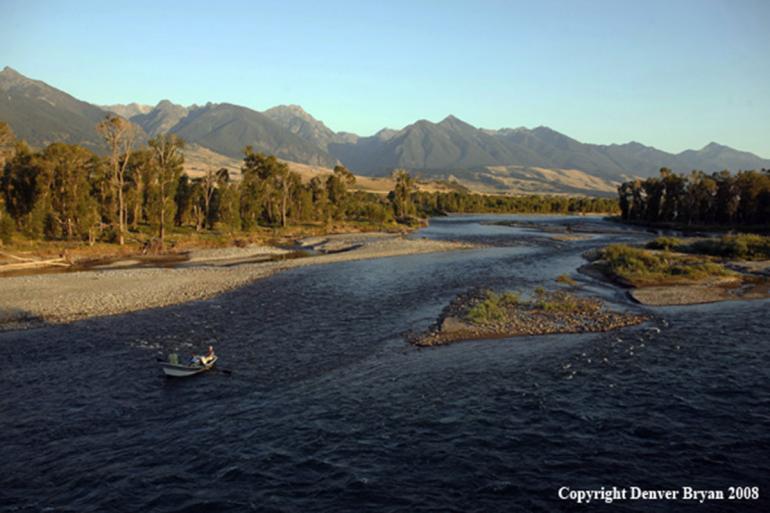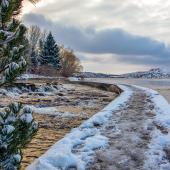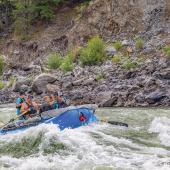The Upper Yellowstone
A fisher's paradise.
The Upper Yellowstone River conveys a certain wildness of spirit. You’ve most likely heard that the Yellowstone is the longest undammed river in the Lower 48, but it’s more than that. It’s in the raging flows of runoff that can last into mid-July. It’s in the elk, deer, eagles, otters, and bison that inhabit her shores. It’s in the spectacular mountain backdrops of Paradise Valley. And it’s in the fish that survive and thrive in this most natural of settings. For an angler, this wildness can be intimidating, but it needn’t be. The stretch of the Yellowstone River from Gardiner through Livingston can be one of the state’s most rewarding.
Access
More than 15 public access sites can be found between Gardiner and Livingston. Most have boat ramps and are spaced out to make half-day and full-day floats possible. Wade fishing is often good at these access points and thanks to Montana’s stream-access law, solitude can usually be found a short walk away (staying below the high-water line, of course). To avoid some of the boat traffic, try fishing upstream of the access in the morning and downstream later in the day.
Flows
Runoff is a big deal on the Yellowstone. Literally. Peak flows can reach 25,000 cfs near Livingston, usually around the beginning of June. Intrepid rowers are back on the river at around 10,000 cfs (toward the end of June), but it’s still a big and dangerous river. Choose one of the mellower stretches such as the “bird float” between Grey Owl and Mallard’s Rest if you’re not a pro on the oars. The river can fish well anytime there’s a foot or more of clarity. But the “magic moment” for all-around action is approximately 5,000 cfs.
When to Go & What to Use
Some of the best fishing of the year can occur before runoff, if you’re ready for the ever-changing elements. Nymphing is the most popular technique, but midges, blue-winged olive (baetis), and March browns can bring trout to the surface. And a slowly-stripped streamer can hook you up with some of the Yellowstone’s bigger denizens.
The Mother’s Day caddis hatch (around the first week of May) is legendary. Bugs can blanket the water, making for tough fishing. Try an imitation a bit larger or smaller than the real thing, and don’t forget about emergers, especially if you’re seeing splashy rises. The hatch tends to be best right around Livingston and flirts with the beginning of runoff, so be ready to take a sick day if you hear “it’s on!”
The end of runoff, if we’re lucky, coincides with another renowned hatch: the salmon fly. These monstrous stoneflies can bring big trout smashing to the surface. The hatch tends to progress upstream a few miles each day. If a parade of boats is not your style, try fishing upstream of the hatch, drifting big stonefly nymphs right along the willows. Or fish a stretch that the hatch has already passed; fish will continue to look up for the big bugs for a few days.
Good dry fly fishing continues through the summer months (goldenstones, caddis, yellow sallies, PMDs, to name a few), but the next “big thing” on the Yellowstone is the grasshopper emergence in late summer. Warm breezes blow the terrestrials into the water and the trout are ready for a big meal. Gaudy foam sandwiches can pick up fish early in the hopper season. As the fish see the daily parade of foam, more realistic patterns are going to be more productive. Take your time on the hook-set so as not to be fooled by the agonizingly slow take of a native cutthroat.
Autumn is streamer time. As they prepare to spawn, big browns get aggressive and the fish are looking for hearty meals to prepare for the lean winter months. Trophy hunting may involve a shoulder-taxing day of chucking five-inch-long monstrosities with seven-weight rods and sinking lines. But nice fish can be picked up on more reasonably-sized streamers and tackle.
Row vs. Wade
The Yellowstone is often seen as a float-fishing destination. Floating allows the angler to hit a large number of productive spots in a day. But wade fishing can be equally effective, allowing the angler time to concentrate on a few fruitful pools or riffles. Some of the best wade fishing can be found in the stretch between Gardiner and the head of Yankee Jim Canyon. Wading opportunities exist throughout the Upper Yellowstone—stop in any of the local fly shops and the staff will be happy to point you toward some good locations.
Fish
The Upper Yellowstone is home to rainbow, brown, and native Yellowstone cutthroat trout. Cutthroats are more prevalent in the upper stretches, toward Gardiner, and browns pick up the farther downstream you go.
Regulations
Regulations on the Yellowstone are relatively straightforward. All cutthroats must be released; if it has a slash, put it back.
Getting There
Livingston, right off I-90, is the gateway to the Upper Yellowstone. Take exit 333 toward Gardiner and Yellowstone National Park. Highway 89 parallels the river all the way up to Gardiner. Some of the less-crowded accesses are on the scenic East River Road, which can be reached via several bridge crossings.
Dan Gigone owns Sweetwater Fly Shop in Livingston.












